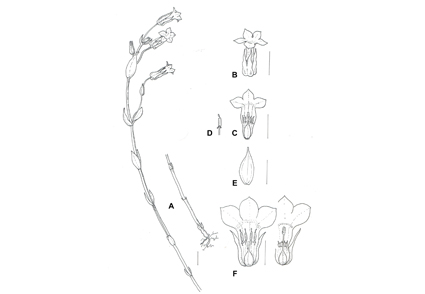Abstract
Based on morphological and ecological considerations, Belmontia natalensis (syn. Exochaenium grande var. homostylum) is reinstated as Exochaenium natalense (Gentianaceae). It only occurs in a section of the coastal region of the Eastern Cape (Pondoland) and southern KwaZulu-Natal provinces, South Africa. Exochaenium natalense differs from E. grande, the only other South African Exochaenium taxon, by having smaller flowers (corolla diameter < 2 cm vs > 3 cm) with a different colour (white vs cream-salmon or yellow). Because the type material of E. natalense consists of two sheets, a lectotype is designated.
References
- Grisebach, A.H.R. (1845) Gentianaceae. In: Candolle, A. de (Ed.) Prodromus systematis naturalis regni vegetabilis, vol. 9. Fortin, Masson et Sociorum, Paris, pp. 39–141. [https://www.biodiversitylibrary.org/item/247794#page/43/mode/1up]
- Hill, A.W. (1908) Notes on Sebaea and Exochaenium. Bulletin of Miscellaneous Information (Royal Gardens, Kew) 1908: 317–341. https://doi.org/10.2307/4111714
- Hill, A.W. & Prain, D. (1909) Gentianaceae. In: Thiselton-Dyer, W.T. (Ed.) Flora Capensis. Vol. IV, Section 1. Lovell Reeve & Co. LTD, London, pp. 1056–1121. [https://www.biodiversitylibrary.org/item/15242#page/1070/mode/1up]
- Kissling, J. (2012) Taxonomy of Exochaenium and Lagenias: two resurrected genera of tribe Exaceae (Gentianaceae). Systematic Botany 37 (1): 238–253. https://doi.org/10.1600/036364412X616800
- Kissling, J. (2015) Exochaenium clavatum subsp. stella-pallustre (Gentianaceae—Exaceae), a new subspecies from Zambia. Phytotaxa 203 (3): 297–300. https://doi.org/10.11646/phytotaxa.203.3.10
- Kissling, J. & Barrett, S.C.H. (2013) Variation and evolution of herkogamy in Exochaenium (Gentianaceae): implication for the evolution of distyly. Annals of Botany 112 (1): 95–102. https://doi.org/10.1093/aob/mct097
- Kissling, J., Yuan, Y.-M., Küpfer, P. & Mansion, G. (2009) The polyphyletic genus Sebaea (Gentianaceae): A step forward in understanding the morphological and karyological evolution of the Exaceae. Molecular Phylogenetics and Evolution 53 (3): 734–748. https://doi.org/10.1016/j.ympev.2009.07.025
- Linnaeus, C. (1753) Species Plantarum. Vol. 1. Holmiae, Impensis Laurentii Salvii, pp. 135, 142, 271. https://doi.org/10.5962/bhl.title.669
- Marais, W. & Verdoorn, I.C. (1963) Gentianaceae. In: Dyer, R.A., Codd, L.E. & Rycroft, H.B. (Eds.) Flora of Southern Africa. Vol. 26. Government Printer, Pretoria, pp. 172–211.
- Meyer, E.H.F. (1837) Commentariorum de plantis Africae Australioris. Vol. 1, fascic. 2. Leopold Voss, Leipzig, 326 pp. https://doi.org/10.5962/bhl.title.50
- Mucina, L. & Rutherford, M.L. (2006) The vegetation of South Africa, Lesotho and Swaziland. Strelitzia 19. South African National Biodiversity Institute, Pretoria, pp. 1–816.
- Schinz, H. (1894) Beitraege zur Kenntnis der Afrikanischen Flora. Bulletin de l’Herbier Boissier 2: 180–228. [https://www.biodiversitylibrary.org/item/105264#page/200/mode/1up]
- Schinz, H. (1896) Gentianaceae. Bulletin de l’Herbier Boissier 4: 442–444. [https://www.biodiversitylibrary.org/item/104951#page/476/mode/1up]
- Schinz, H. (1906) Gentianaceae. Bulletin de l’Herbier Boissier, Sér. 2, 6: 714–746. [https://www.biodiversitylibrary.org/item/105785#page/794/mode/1up]
- Theirs, B. (2022 [continuously updated]) Index Herbariorum: A global Directory of Public Herbaria and Associated Staff. New York Botanical Garden’s Virtual Herbarium. Available from: http://sweetgum.nybg.org/science/ih/ (Accessed 15 August 2022).
- Turland, N.J., Wiersema, J.H., Barrie, F.R., Greuter, W., Hawksworth, D.L., Herendeen, P.S., Knapp, S., Kusber, W.-H., Li, D.-Z., Marhold, K., May, T.W., McNeill, J., Monro, A.M., Prado, J., Price, M.J. & Smith, G.F. (Eds.) (2018) International Code of Nomenclature for algae, fungi, and plants (Shenzhen Code) adopted by the Nineteenth International Botanical Congress Shenzhen, China, July 2017. Regnum Vegetabile 159. Koeltz Botanical Books, Glashütten. https://doi.org/10.12705/Code.2018
- Wolfe, L.M., Massinga, P.H. & Johnson, S.D. (2009) A quantitative evaluation of the distylous syndrome in Sebaea grandis (Gentianaceae). South African Journal of Botany 75 (4): 785–790. https://doi.org/10.1016/j.sajb.2009.07.014


